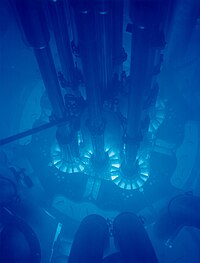
Photo from wikipedia
We present a relativistic formulation of the energy loss of a charged particle traversing an anisotropic layer under arbitrary angle of incidence. We use a model for the conductivity tensor… Click to show full abstract
We present a relativistic formulation of the energy loss of a charged particle traversing an anisotropic layer under arbitrary angle of incidence. We use a model for the conductivity tensor describing doped phosphorene, which supports plasmon polariton modes (PPMs) that exhibit a topological transition between elliptic and hyperbolic iso-frequency dispersion curves in the THz to the mid-infrared (MIR) frequency range. The total distribution of the momentum transfer and energy loss of the charged particle goes to excitation of the PPMs followed by their decay in phosphorene (Ohmic losses) and the energy that is emitted as transition radiation (TR). We show that the elliptic modes are efficiently excited in the THz range by relativistic particles, but the corresponding Ohmic distributions do not exhibit significant anisotropy. Contrastingly, hyperbolic modes are efficiently excited in the MIR range by slow particles moving under oblique incidence, producing Ohmic distributions that show strong directionality of propagation with large wavevectors associated with the asymptotes of the hyperbolic dispersion curves. The most dramatic effects of the anisotropic layer conductivity are seen in the angular spectra of the TR, with quite distinct and unexpected shapes of the radiation patterns emitted at the THz and MIR frequencies, even for a normal incidence of the charged particle. Those patterns are substantially skewed for oblique incidence, when they show a marked anisotropy relative to the principal axes of the layer. Such a rich variety of the TR spectra should be readily observable via angle-resolved measurements in a transmission electron microscope.
Journal Title: Nanoscale
Year Published: 2022
Link to full text (if available)
Share on Social Media: Sign Up to like & get
recommendations!